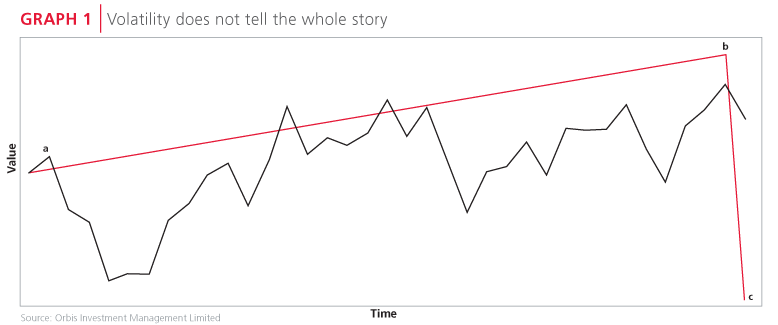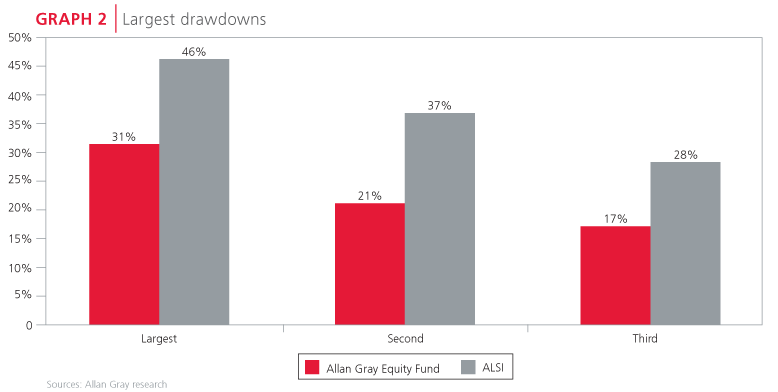Discussions about investing are incomplete without including the topic of risk. Delphine Govender elaborates, focusing on the most important risk in investing in our view: the risk of permanently losing money.
"Risk: The possibility of loss, injury, or other adverse or unwelcome circumstance; a chance or situation involving such a possibility." (Oxford English Dictionary - 17th Century)
"Rule no.1: Never lose money and Rule no.2: Never forget Rule no.1." (Warren Buffet)
At Allan Gray, we define risk as the probability of a permanent loss of capital. However, we are mindful that other market participants and investors tend to focus on other definitions of risk which they see as being more relevant, namely:
1. Risk as volatility
2. Risk as being different from a benchmark or index
Risk is not volatility
One of the most commonly applied definitions to risk in investing is that of equating risk to volatility. Volatility (also referred to as 'standard deviation') essentially measures how much an investment's return varies from its average over time. Consider Graph 1 where the black line illustrates a return series on an investment that from point (a) to (b) is highly volatile falling, rising, falling, rising and so forth. An investor who sees volatility as risk would find such an investment very risky simply because the investment's returns vary frequently from the average return and move in different directions. With risk as volatility, the relationship between the intrinsic value of an investment and its price is downplayed, as is the intrinsic risk of the company's operations or financial structure. On the other hand, the bumpy journey between the two points is given considerably more weight and attention.
By contrast, however, the same investor may see an investment that follows the path of the red line between point (a) and (b) to be essentially risk-free, as the pattern of performance is a linear return. The fact that this same investment was wiped out at point (c) in a single event very soon after point (b) is not factored in, as up to that point the investment exhibited very low volatility in its returns.
The problem we see with using volatility as a gauge of risk, is that volatility is mostly an indicator of changes in the perceived value of an investment based on the fluctuations of historic return patterns. It therefore gives you no sense of the possibility of an intrinsic looming threat to returns. In our opinion, the best predictor of returns is the price you pay for the investment relative to its intrinsic value and risk.
WE DEFINE RISK AS THE PROBABILITY OF A PERMANENT LOSS OF CAPITAL
Risk is not being different
Another popular interpretation of risk is that risk is being different, as measured by tracking error. Tracking error is the statistical amount by which the returns of a particular share differ from those of a benchmark. A share whose returns differ widely from a specific benchmark (usually an index) is considered to have a high tracking error and is therefore considered high risk. We accept that for an investor whose objective is for returns to mimic an index, tracking error is a relevant risk measure. However, for an investor aiming to create long-term wealth, defining risk as tracking error simply does not make sense.

Consider the following example: to minimise tracking error, in June 2008 an investor concerned with this kind of risk may have attempted to keep his/her weighting in Anglo American, one of the two largest shares in the FTSE/JSE All Share Index (ALSI), close to the index weighting of the share around 16.5%. If the above investor was pessimistic about the prospects of Anglo American relative to the ALSI, he or she may have adopted an underweight position in the share versus its ALSI weight owning, for example, 5% less than the benchmark weight. So, despite being negative on Anglo American as an investment, the same investor could have in excess of 10% of his/her portfolio in the share.
The shortcoming of this approach is that, in reality from end June 2008 to 1 March 2009, Anglo American fell over 70% in absolute terms, while the ALSI fell about 40% over the same period. In other words, owning a share that is fundamentally overpriced, even if you are underweight its benchmark weighting, does not offer protection from the downside risk of that share.
Risk is losing money
To us, investment risk is not about how variable a share's returns are over history, either versus its own average or that of any pre-selected benchmark. It is simply the probability of permanently losing money from an investment.
In concerning ourselves with risk in this way, it is important to be aware not only of the possibility of loss, but also the potential magnitude of the loss. Given a long-term history, you can assess this for a fund as the largest peak-to-trough decline in returns over the period, also known as the 'maximum drawdown'.
In Graph 2 (below) we highlight in red the three largest drawdowns experienced in the Allan Gray Equity Fund (AGEF) since its inception in 1998, compared to that of the ALSI. As you can see, the single largest decline in the AGEF was a reduction in capital of 31%, whereas the largest drawdown in the ALSI was 46%.
Equally important is to consider how long it takes for an investment to bounce back following a decline in investing speak, we refer to this as 'months to recovery'. Over its history, the average months to recovery in the AGEF is approximately nine months; the ALSI took more than double this time to recover (19 months).
AT ALLAN GRAY WE ACT... WITHOUT FEAR OF BEING DIFFERENT
Benjamin Graham, the father of securities analysis, maintained that a potential decline in the price of a share does not ultimately raise the risk of loss if the decline is temporary and if the probability of selling during the decline is low. Graham applied the concept of risk solely to a loss of value, which may be realised through actual sale; caused by a significant deterioration in the company's position; or, more frequently, may be the result of overpaying for an investment relative to its true intrinsic worth.
Since our primary definition of risk is the probability and the extent of capital loss, we always try to invest in businesses on behalf of our clients when share prices are well below our assessment of intrinsic value and we are offered some protection should things turn out worse than we forecast (i.e. a 'margin of safety' exists). We believe that to invest where value is exceptional is not only the lowest risk, but also the most rewarding strategy. If our research shows that particular investments are overpriced, we consider them risky and will not purchase them for our clients. Conversely, we consider it prudent to invest in assets that we believe offer exceptional value even if they are out of favour and not represented in the average portfolios. This means that our portfolios often differ markedly from those of the average investment manager.

Being mindful of risk is not the same as being afraid
After reading this article devoted exclusively to risk and given our attitude towards investment risk, some readers might conclude that as an investment house we are extremely conservative. If being fiercely protective about preserving our clients' capital is considered highly conservative, then that is a label we will readily wear. If, however, conservatism is construed as being afraid to act boldly then nothing could be further from our investment mindset and behaviour.
At Allan Gray we act with conviction, without fear of being different to consensus thinking, or the conventional wisdom of the day. Being consistently and consciously mindful of the possibility of a permanent loss of our clients' capital does not and has not precluded us from seeking out the best longterm wealth-creating investment opportunities for our clients. Internalising risk in the way that we do is a key aspect of our investment philosophy and perhaps one of the most important contributors to our long-term performance track record.